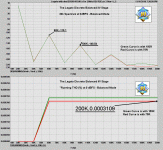the current output of a single buffalo II is 16ma.
guys i have one question too.
i don`t have i2s to feed the buffalo modules.
can it be done with paraled coaxial or it would spoil the 75ohm standard?
my other option is to use the 2 transformer isolated outputs from musiland.
one is with rca and the other is with bnc.
this will be for testing purpose only.
if i like it and buy a second buffalo for myself
i will change the connectors to use the same at both channels.
guys i have one question too.
i don`t have i2s to feed the buffalo modules.
can it be done with paraled coaxial or it would spoil the 75ohm standard?
my other option is to use the 2 transformer isolated outputs from musiland.
one is with rca and the other is with bnc.
this will be for testing purpose only.
if i like it and buy a second buffalo for myself
i will change the connectors to use the same at both channels.
the current output of a single buffalo II is 16ma.
guys i have one question too.
i don`t have i2s to feed the buffalo modules.
can it be done with paraled coaxial or it would spoil the 75ohm standard?
my other option is to use the 2 transformer isolated outputs from musiland.
one is with rca and the other is with bnc.
this will be for testing purpose only.
if i like it and buy a second buffalo for myself
i will change the connectors to use the same at both channels.
No need to buffer if you use I2S source as the impedance is pretty high. If your using any of our I2S sources the outputs are perfectly capable driving the load and are designed to do so.
If your using SPDIF the solution is similarly quite simple. Use one Buffalo II with normal SPIDF input. On the other leave the SPDIF switch open. Now connect D1 and GND between the DACs. This will make a single comparator drive D1 with TTL level SPDIF on both DACs. Something it can do quite easily. This works very well and is how I did some of my testing.
Cheers!
Russ
Is this helpful in anyway?
Next question. Since you used 2 Buffalo II modules, obviously the current doubled. What did you end up changing on the Legato module in order to get 1.5V to 2V rms at 0dBfs? It's important to find out what this current is as others who would like to implement a differential I/V stage, whether tubed or solid state or transformer, will need this info to make sure their favorite I/V stage can handle this level of current.
Does anybody know what the current output is of a single buffalo II module?
Thanks,
Anand.
Hi Anand
Or even "Dzień Dobry"
Well this is really good question how Legato is reflecting double current from Buffalo side. In theory this would be 2x16ma about 30-32ma and this is definitely few times more that other “I output DAC” I know. And I/U stage have to be designed to work on that high output current level.
At "Legato or IVY III" thread IngemarR did post simulation of Legato with some very nice results, I will try to ask him about possibility or running his simulation again with double current from Buffalo. Maybe he will find this subject interesting, and we could see how this works, at list on simulations.
As for higher output level at Legato this is of cause the case, output level is higher. If this is interesting for You I can check the real situation with the scope, this actually is interesting.
As for lowering Legato output level, there is very nice "Legato Tweekers" thread if I remember correctly, where this is explained by "the Legato maker" himself...😀 so this could be "the best source" if You wish to do this.
As for me I "like" the higher than standard output levels, but I mod my PowerAmp, I feed directly from Legato, to be able to work with this. And for me this is another advantage of this setup.
Best Regards
Rosendorfer
I am not an engineer. In fact, I am a layman, but a very curious layman,
Jose
Hi Jose
... are You sure about calling Yourself "layman"... this just doesn't relay seems to fit Your knowledge...
I'm sure You will have a lot of fun while get the Buffalo....😀
Best Regards
Rosendorfer
Is this helpful in anyway?
off course it is.
that`s all i wanted.
thanks.
Hi Anand
Or even "Dzień Dobry"
Well this is really good question how Legato is reflecting double current from Buffalo side. In theory this would be 2x16ma about 30-32ma and this is definitely few times more that other “I output DAC” I know. And I/U stage have to be designed to work on that high output current level.
At "Legato or IVY III" thread IngemarR did post simulation of Legato with some very nice results, I will try to ask him about possibility or running his simulation again with double current from Buffalo. Maybe he will find this subject interesting, and we could see how this works, at list on simulations.
As for higher output level at Legato this is of cause the case, output level is higher. If this is interesting for You I can check the real situation with the scope, this actually is interesting.
As for lowering Legato output level, there is very nice "Legato Tweekers" thread if I remember correctly, where this is explained by "the Legato maker" himself...😀 so this could be "the best source" if You wish to do this.
As for me I "like" the higher than standard output levels, but I mod my PowerAmp, I feed directly from Legato, to be able to work with this. And for me this is another advantage of this setup.
Best Regards
Rosendorfer
Legato copes quite well with the higher current, but you will want to reduce the I/V resistor.
I am sorry I have not had to time to read the whole thread yet. It looks like you are doing well. If you need any specific questions still answered let me know.
Good work! 🙂
Cheers!
Russ
i did a simulation with a Legato driven by two ESS9018, ie the current into the Legato is 32mAp-p AC at 0 dBFS. Fequency is 20 kHz.
My sim of the Legoto with one ESS9018 is here
http://www.diyaudio.com/forums/twisted-pear/166975-legato-ivy-iii-outputs-buffalo-ii-11.html#post2309745
Do note that I did not change the IV resistor as per Russ recommendation. Thus, output voltage is 3.2Vrms.
/IR
My sim of the Legoto with one ESS9018 is here
http://www.diyaudio.com/forums/twisted-pear/166975-legato-ivy-iii-outputs-buffalo-ii-11.html#post2309745
Do note that I did not change the IV resistor as per Russ recommendation. Thus, output voltage is 3.2Vrms.
/IR
Attachments
-
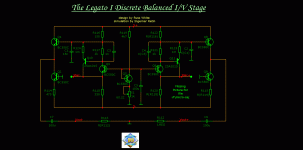 Legato with dual ESS9018 DACs For 20kHz REV R2E.GIF41.6 KB · Views: 639
Legato with dual ESS9018 DACs For 20kHz REV R2E.GIF41.6 KB · Views: 639 -
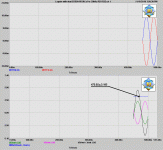 Legato with dual ESS9018 DACs For 20kHz REV R2E RMS Bal.GIF41.1 KB · Views: 609
Legato with dual ESS9018 DACs For 20kHz REV R2E RMS Bal.GIF41.1 KB · Views: 609 -
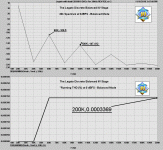 Legato with dual ESS9018 DACs For 20kHz REV R2E Balanced Mode.GIF56.7 KB · Views: 616
Legato with dual ESS9018 DACs For 20kHz REV R2E Balanced Mode.GIF56.7 KB · Views: 616 -
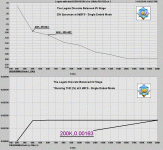 Legato with dual ESS9018 DACs For 20kHz REV R2E SE Mode.GIF52.4 KB · Views: 613
Legato with dual ESS9018 DACs For 20kHz REV R2E SE Mode.GIF52.4 KB · Views: 613
Russ,
what resistor value changes do you recommend for running the Legato from dual BuffaloII:s?
/IR
what resistor value changes do you recommend for running the Legato from dual BuffaloII:s?
/IR
Legato copes quite well with the higher current, but you will want to reduce the I/V resistor.
Cheers!
Russ
Hi IngemarR
Thanks for Your post ..!!
Your simulations are very interesting...
Please correct me if I'm wrong but it seems that for
lets call this: normal stereo mode with 16ma input current at Legato the simulations results are absolutely much better.
The 3-rd harmonics, 60Khz with normal stereo mode we get -125,6dB and at Dual mode with 32ma input current at Legato there is -109,5dB this is like 16,1 dB difference.
And THD at normal stereo mode 60kHz Up is 0,0000772% and with Dual mode 0,0003369%.
So it looks that we get signal level up, but we do loose pretty much on distortion..having higher signal level.
Best Regards
Rosendorfer
Thanks for Your post ..!!
Your simulations are very interesting...
Please correct me if I'm wrong but it seems that for
lets call this: normal stereo mode with 16ma input current at Legato the simulations results are absolutely much better.
The 3-rd harmonics, 60Khz with normal stereo mode we get -125,6dB and at Dual mode with 32ma input current at Legato there is -109,5dB this is like 16,1 dB difference.
And THD at normal stereo mode 60kHz Up is 0,0000772% and with Dual mode 0,0003369%.
So it looks that we get signal level up, but we do loose pretty much on distortion..having higher signal level.
Best Regards
Rosendorfer
If you reduce the I/V resistor by half you will get much better performance.
The reason for the increase in THD is the much larger voltage swing at the output.
You could also increase the static current by reducing the 330R CCS resistors. But that may not be necessary or desirable.
The reason for the increase in THD is the much larger voltage swing at the output.
You could also increase the static current by reducing the 330R CCS resistors. But that may not be necessary or desirable.
Here is where using the parallel mosfets will get you the extra mile. 🙂
I do agree though that there is little if any benefit to running 32ma into Legato. It would be a bit better two run two Legatos much like the IVY-III.
I do agree though that there is little if any benefit to running 32ma into Legato. It would be a bit better two run two Legatos much like the IVY-III.
Though I have not tried it you should be able to simply parallel the outputs of each legato as long as you don't use the buffer. No need to take the SE output.
If I have time I will give it a go.
If I have time I will give it a go.
Not sure I follow what would be scary. 🙂 Perhaps I did not explain well?
You would connect the same phase from one side of the legato to the other. You just have to keep in mind that they are inverted so the + on one side would connect to the - on the other.
I will try to draw a picture when I get a chance.
One benefit is you get half the output impedance. 🙂
You would connect the same phase from one side of the legato to the other. You just have to keep in mind that they are inverted so the + on one side would connect to the - on the other.
I will try to draw a picture when I get a chance.
One benefit is you get half the output impedance. 🙂
Here's a comparison between 75R and 150R as IV resistors with dual Buffalo driving Legato 1. Hardly any difference in my sim.
This is at 20 kHz as earlier, and I think it is excellent performance.
/IR
Hi IngemarR
Could You make simulation for single ended output and if possible also output without the buffer, so we can see if this is making any difference.
60kHz 3-rd harmonics at -110dB is absolutely great resoult ...😎 but I'm bit puzzled why there is so big difference against normall stereo version @ -125,6dB, specially that it seems that this is not simply corelated with higher output level.
And any chances You could run Your simulation on "parallel mosfets" Legato 2 version....?
Best Regards
Rosendorfer
- Status
- Not open for further replies.
- Home
- More Vendors...
- Twisted Pear
- Buffallo Dual Mono 1 Legato
